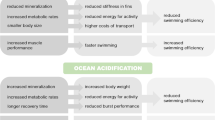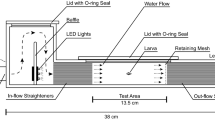Abstract
Flexible traits can be crucial in helping animals meet the challenges of a highly variable environment. We examined whether coral reef fishes systematically alter their swimming behaviour in response to temporal changes in hydrodynamic conditions. Exploiting site-based differences in wave energy impinging on reef habitats over calm and rough weather, we found many reef fishes changed their swimming behaviour alongside increases in wave-driven water motion. Most fishes tended to orient their bodies parallel to oncoming wave-driven flow and recruited additional stabilising fins during rough weather; such changes in swimming behaviour aid stability and minimise drag. However, not all species displayed such flexibility, with fishes possessing highly tapered pectoral fins and high levels of swimming performance continuing to successfully navigate reef habitats without significantly altering their swimming behaviour. We highlight how labile behaviours augment the morphology and performance of species to underpin their occupation of habitats subject to variable environmental conditions.






Similar content being viewed by others
References
Arnold GP (1974) Rheotropism in fishes. Biol Rev Camb Phil Soc 49:515–576
Arnold GP, Weihs D (1978) The hydrodynamics of rheotaxis in the plaice (Pleuronectes platessa). J Exp Biol 75:147–169
Bay LK, Crozier RH, Caley MJ (2006) The relationship between population genetic structure and pelagic larval duration in coral reef fishes on the Great Barrier Reef. Mar Biol 149:1247–1256
Bay LK, Caley MJ, RH Crozier (2008) Meta-population structure in a coral reef fish demonstrated by genetic data on patterns of migration, extinction and re-colonisation. BMC Evol Biol 8:248
Bellwood DR, Wainwright PC, Fulton CJ, Hoey A (2002) Assembly rules and functional groups at global biogeographical scales. Funct Ecol 16:557–562
Blake RW, Chan KHS (2010) Biomechanics of rheotactic behaviour in fishes. In: Domenici P, Kapoor BG (eds) Fish locomotion: an eco-ethological perspective. Science Publishers, Enfield, pp 40–61
Crawley MJ (2007) The R book. Wiley, West Sussex
Dadda M, Pilastro A, Bisazza A (2005) Male sexual harassment and female schooling behaviour in the eastern mosquitofish. Anim Behav 70:463–471
Depczynski M, Bellwood DR (2005) Wave energy and spatial variability in community structure of small cryptic coral reef fishes. Mar Ecol Prog Ser 303:283–293
Fulton CJ (2007) Swimming speed performance in coral reef fishes: field validations reveal distinct functional groups. Coral Reefs 26:217–228
Fulton CJ (2010) The role of swimming in reef fish ecology. In: Domenici P, Kapoor BG (eds) Fish locomotion: an eco-ethological perspective. Science Publishers, Enfield, pp 374–406
Fulton CJ, Bellwood DR (2002) Patterns of foraging in labrid fishes. Mar Ecol Prog Ser 226:135–142
Fulton CJ, Bellwood DR (2005) Wave-induced water motion and the functional implications for coral reef fish assemblages. Limnol Oceanogr 50:255–264
Fulton CJ, Bellwood DR, Wainwright PC (2001) The relationship between swimming ability and habitat use in wrasses (Labridae). Mar Biol 139:25–33
Fulton CJ, Bellwood DR, Wainwright PC (2005) Wave energy and swimming performance shape coral reef fish assemblages. Proc R Soc B 272:827–832
Goatley CHR, Bellwood DR (2011) The roles of dimensionality, canopies and complexity in ecosystem monitoring. PLoS One 6(11):e27307
Harris JE (1938) The role of the fins in the equilibrium of the swimming fish II: the role of the pelvic fins. J Exp Biol 15:32–47
Heggenes J (1988) Effects of short-term flow fluctuations on displacement of, and habitat use by, brown trout in a small stream. Trans Am Fish Soc 117:336–344
Jago OK, Kench PS, Brander RW (2007) Field observations of wave-driven water-level gradients across a coral reef flat. J Geophys Res 112:1–14
Kawamata S, Hasegawa M (2006) Effects of oscillating water flow on feeding of rabbitfish Siganus fuscescens on kelp. Nipp Suisan Gakk 72:717–724
Komers PE (1997) Behavioural plasticity in variable environments. Can J Zool 75:161–169
Korsmeyer KE, Steffensen JF, Herskin J (2002) Energetics of median and paired fin swimming, body and caudal fin swimming, and gait transition in parrotfish (Scarus schlegeli) and triggerfish (Rhinecanthus aculeatus). J Exp Biol 205:1253–1263
Kümmerli R, Jiricny N, Clarke LS, West SA, Griffin AS (2009) Phenotypic plasticity of a cooperative behaviour in bacteria. J Exp Biol 22:589–598
Leal M, Powell BJ (2012) Behavioural flexibility and problem-solving in a tropical lizard. Biol Lett 8:28–30
Liao JC (2007) A review of fish swimming mechanics and behaviour in altered flows. Phil Trans R Soc B 362:1973–1993
Losos JB, Warheit KI, Schoener TW (1997) Adaptive differentiation following experimental island colonization in Anolis lizards. Nature 387:70–73
Lupandin AI (2005) Effect of flow turbulence on swimming speed of fish. Biol Bull 32:461–466
Meekan MG, Steven ADL, Fortin MJ (1995) Spatial patterns in the distribution of damselfishes on a fringing coral reef. Coral Reefs 14:151–161
Piersma T, Drent J (2003) Phenotypic flexibility and the evolution of organismal design. Trends Ecol Evol 18:228–233
Pink J (2012) Behavioural modality in swimming and foraging by coral reef fishes. Dissertation, The Australian National University
Randall JE, Allen GR, Steene RC (1997) Fishes of the Great Barrier Reef and Coral Sea (2nd edn). Crawford House Publishing Pty Ltd, Bathurst
Tritico HM, Cotel AJ (2010) The effects of turbulent eddies on the stability and critical swimming speed of creek chub (Semotilus atromaculatus). J Exp Biol 213:2284–2293
Turgeon K, Robillard A, Grégoire J, Duclos V, Kramer DL (2010) Functional connectivity from a reef fish perspective: behavioural tactics for moving in a fragmented landscape. Ecology 91:3332–3342
Walker JA, Westneat MW (2002) Kinematics, dynamics, and energetics of rowing and flapping propulsion in fishes. Int Comp Biol 42:1032–1043
Webb PW (1994) The biology of fish swimming. In: Maddock L, Bone Q, Rayner JMV (eds) Mechanics and physiology of animal swimming. Cambridge University Press, Cambridge, pp 45–62
Webb PW (2002) Control of posture, depth, and swimming trajectories of fishes. Int Comp Biol 42:94–101
Webb PW (2004) Response latencies to postural disturbances in three species of teleostean fishes. J Exp Biol 207:955–961
Webb PW, Cotel A, Meadows LA (2010) Waves and eddies: effects on fish behavior and habitat distribution. In: Domenici P, Kapoor BG (eds) Fish locomotion: an eco-ethological perspective. Science Publishers, Enfield, pp 1–39
Weihs D (1993) Stability of aquatic animal locomotion. Cont Math 141:443–461
Welsh JQ, Bellwood DR (2012) Spatial ecology of the steephead parrotfish (Chlorurus microrhinos): an evaluation using acoustic telemetry. Coral Reefs 31:55–65
West-Eberhard MJ (2003) Developmental plasticity and evolution. Oxford University Press, New York
Whitlock MC, Schluter D (2009) The analysis of biological data. Roberts and Company Publishers, Colorado
Williams DMcB (1982) Patterns in the distribution of fish communities across the central Great Barrier Reef. Coral Reefs 1:35–43
Wund MA (2005) Learning and the development of habitat-specific bat echolocation. Anim Behav 70:441–450
Young IR, Zieger S, Babanin AV (2011) Global trends in wind speed and wave height. Science 332:451–455
Acknowledgments
Our study was conducted at Jiigurru (Lizard Island), in the country of the Dingaal people. We thank S. Binning, D. Roche, R. Sheb’a, and the staff from Lizard Island Research Station for their assistance during field work. Thanks to D. Roche and S. Binning for statistical advice, and M. Noble for assistance with illustrations and constructive feedback on the manuscript. Funding was provided by the Australian Research Council (CJF), the Australian National University (CJF, SJH), and the Anjeli Nathan Memorial Scholarship (SJH). The study was conducted under Great Barrier Reef Marine Park Authority permit G09/30054.1 and ANU Animal Experimentation Ethics Committee approval F.BTZ.41.10.
Author information
Authors and Affiliations
Corresponding author
Additional information
Communicated by D. Goulet.
Electronic supplementary material
Below is the link to the electronic supplementary material.
Rights and permissions
About this article
Cite this article
Heatwole, S.J., Fulton, C.J. Behavioural flexibility in reef fishes responding to a rapidly changing wave environment. Mar Biol 160, 677–689 (2013). https://doi.org/10.1007/s00227-012-2123-2
Received:
Accepted:
Published:
Issue Date:
DOI: https://doi.org/10.1007/s00227-012-2123-2




